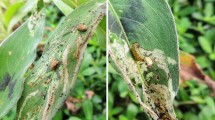Abstract
Nymph and adult biology of Glyphepomis spinosa Campos & Grazia (Hemiptera: Pentatomidae) was studied on rice plants under laboratory and greenhouse conditions. The full life cycle of G. spinosa lasted 50.1 day. Nymph development ranged from 2.7 days for the first instar up to 11.9 days for the fifth instar. The egg stage showed the highest per capita rate of mortality (0.16). Nearly 13% of all eggs were laid on the same day. The sex ratio was 0.5. The average hatching rate was 58.0%. Pre-oviposition, oviposition, and post-oviposition periods took 12.9, 34.4, and 6.2 days, respectively.



Similar content being viewed by others
References
Batay-An EH, Torrena PS, Estoy A (2007) Bioecological studies on rice black bug Scotinophara coarctata (Fabricius) in Cotabato, Mindanao, Philippines, p. 339–359. In: Joshi RC, Barrrion AT, Sebastian LS (eds) Rice black bugs: Taxonomy, ecology, and management of invasive species. Philippine Rice Research Institute, Muñoz, p 787
Botton M, Martins JFS, Loeck AE, Rosenthal MDÁ (1996) Biologia de Tibraca limbativentris Stal sobre Plantas de Arroz. An Soc Entomol Bras 25:21–26
Campos LA, Grazia J (1998) Revisão de Glyphepomis Berg, 1891 (Heteroptera, Pentatomidae, Pentatomini). Rev Bras Entomol 41:203–212
Chocorosqui VR, Panizzi AR (2003) Photoperiod influence on the biology and phenological characteristics of Dichelops melacanthus (Dallas, 1851) (Heteroptera: Pentatomidae). Braz J Biol 63:655–664
Dzerefos CM, Witkowski ETF, Toms R (2009) Life-history traits of the edible stinkbug, Encosternum delegorguei (Hem., Tessaratomidae), a traditional food in southern Africa. J Appl Entomol 133:749–759
Ehler LE (2000) Farmscape ecology of stink bugs in northern California. Tomas Say Publications in Entomology, Entomological Society of America, Lanham, p 59
Ferreira E (1998) Manual de identificação de pragas do arroz. Santo Antônio de Goiás, Embrapa Arroz e Feijão, p 110
Ferreira E, Zimmermann FJP, Santos AB, Neves BP (1997) O percevejo-do-colmo na cultura do arroz. Santo Antônio de Goiás, Embrapa Arroz e Feijão, p 43
Heirichs EA, Miller TA (1991) Rice insects: Management strategies. Springer-Verlag, New York, p 347
Heirichs EA, Domingo LT, Castillo EH (1987) Resistance and yield responses to rice cultivars to the black bug Scotinophara coarctata (F.) (Hemiptera: Pentatomidae). J Plant Prot Trop 4:55–64
Hirose E, Panizzi AR, Cattelan AJ (2006) Effect of relative humidity on emergence and on dispersal and regrouping of first instar Nezara viridula (L.) (Hemiptera: Pentatomidae). Neotrop Entomol 35:757–761
Krebs CJ (1978) Ecology: The experimental analysis of distribution and abundance, 2nd edn. Harper & Row, New York, p 678
Manrique V, Diaz R, Hight SD, Overholt WA (2011) Evaluation of mortality factors using life table analysis of Gratiana boliviana, a biological control agent of tropical soda apple in Florida. Biol Control 59:354–360
Matesco VC, Schwertner CF, Grazia J (2009) Morphology of the immatures and biology of Chinavia longicorialis (Breddin) (Hemiptera: Pentatomidae). Neotrop Entomol 38:74–82
Morrill WL, Shepard BM, Rida GS, Parducho M (1995) Damage by the Malayan black bug (Heteroptera: Pentatomidae) in rice. J Econ Entomol 88:1466–1468
Nielsen AL, Hamilton GC, Matadha D (2008) Developmental rate estimation and life table analysis for Halyomorpha halys (Hemiptera: Pentatomidae). Environ Entomol 37:348–355
Niva CC, Takeda M (2003) Effects of photoperiod, temperature and melatonin on nymphal development, polyphenism and reproduction in Halyomorpha halys (Heteroptera: Pentatomidae). Zool Sci 20:963–970
Panizzi AR, Machado-Neto E (1992) Development of nymphs and feeding habits of nymphal and adult Edessa meditabunda (Heteroptera: Pentatomidae) on soybean and sunflower. Ann Entomol Soc Am 85:477–481
Panizzi AR, Schaefer CW, Hirose E (2005) Biology and descriptions of nymphal and adult Jadera choprai (Hemiptera: Rhopalidae). Ann Entomol Soc Am 98:515–526
Prado SS, Almeida RPP (2009) Role of symbiotic gut bacteria in the development of Acrosternum hilare and Murgantia histrionica. Entomol Exp Appl 132:21–29
Sas Institute Inc. (2006) Cary, Base SAS® 9.1.3 procedures guide, SAS Institute Inc
Silva F, Calizotti GS, Panizzi AR (2011) Survivorship and egg production of phytophagous pentatomids in laboratory rearing. Neotrop Entomol 40:35–38
Simmons AM, Yeargan KV (1988) Development and survivorship of the green stink bug, Acrosternum hilare (Hemiptera: Pentatomidae) on soybean. Environ Entomol 17:527–532
Systat Software, Inc. (2006) Point Richmond, SigmaPlot for Windows, INSO Corporation
Acknowledgments
We thank Leon G. Higley for reviewing this manuscript and Joselia Grazia for species identification. Edmar C. Moura and José F.A. Silva provided technical assistance. This research was supported by The National Council for Scientific and Technological Development (CNPq’s grants 562621/2010-5) and by Brazilian Agricultural Research Corporation (Embrapa’s grants 0211-05).
Author information
Authors and Affiliations
Corresponding author
Additional information
Edited by Antônio R Panizzi – EMBRAPA
Rights and permissions
About this article
Cite this article
Alves, T.M., Barrigossi, J.A.F. & Quintela, E.D. Life Cycle of Glyphepomis spinosa Campos & Grazia (Hemiptera: Pentatomidae): a New Pest of Rice in Brazil. Neotrop Entomol 41, 437–441 (2012). https://doi.org/10.1007/s13744-012-0067-3
Received:
Accepted:
Published:
Issue Date:
DOI: https://doi.org/10.1007/s13744-012-0067-3




